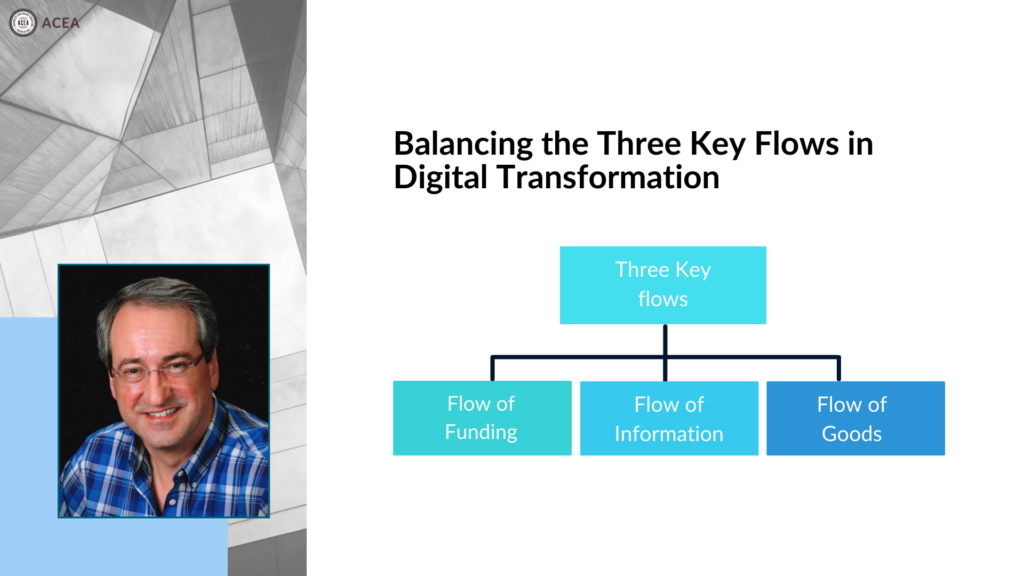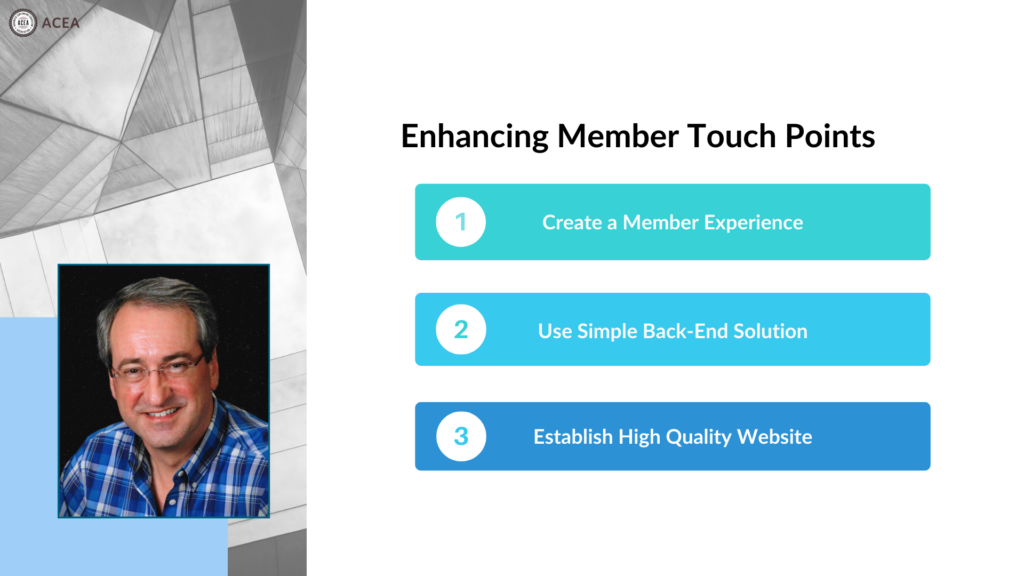Rethinking Continuing Education and Member Experience: Scott Whitmire’s Expert Advice
When considering the value of professional certification, it’s essential to ask some fundamental questions. Is the certification really needed? Will it increase one’s paycheck, job prospects, or access to specialized resources? The certification landscape varies widely with numerous professions and associations, presenting distinct challenges and benefits. Here we discuss how associations can adapt to that change in demand.
Today, we sat down with Scott Whitmire, an esteemed senior enterprise architect with over 35 years of experience in system architecture and software development. He served as VP of Education at ABPMP International and chaired the IASA Global Board of Education. At that time, he oversaw education, training, certification, and accreditation programs for ABPMP and IASA respectively. Renowned for his expertise in business architecture, Whitmire has published books, various papers, and research articles, and is a sought-after speaker in the field. Scott’s extensive experience provides a unique perspective on the role of professional associations in the evolving landscape of their certifications and its impact on various professions.
Key Insights from Scott’s Interview
Throughout the interview, you will get the following key insights:
- Certification Paradox: Professionals often pursue certifications aiming to improve their career prospects. However, there’s a contrasting trend among employers who may favor hiring non-certified individuals due to practical considerations, such as cost efficiency.
- Professional Associations’ Challenges: Scott Whitmire highlights the significant challenges faced by professional associations, including dwindling membership numbers and constrained resources. These issues pose a threat to their continued relevance and effectiveness in their respective fields.
- Varied Importance of Certifications: The significance of certifications differs across industries, from crucial in healthcare to less impactful in technology, highlighting the need for formalization.
- Strategies for Effective Certification Programs: Understanding the user base, assessing usage patterns, evaluating data sharing, and analyzing costs are crucial for a successful certification program.
- Navigating Digital Transformation: Integrating digital processes with traditional operations remains a significant challenge for associations, especially in managing the flow of information, funds, and goods.
- Revitalizing Continuing Education: Associations need to focus on providing engaging and relevant content to keep members’ skills up-to-date and ensure their professional growth.
- Member-Centric Approach for Associations: Creating memorable experiences and focusing on members’ benefits is essential for retaining engagement and loyalty.
- Emphasis on Delivering Real Value: Associations should prioritize thinking through their real purpose primarily helping their members’ overall growth and benefits as professionals.
The Debate on the Need for Professional Certification
Many professionals question the necessity of certifications, often weighing their benefits against potential salary increases or job opportunities. Scott highlights the tension with certified professionals expecting higher pay due to their efforts and organizations’ reluctance to increase expenses. Interestingly, while individuals often pursue certifications hoping for better job prospects or salaries, employers sometimes resist hiring certified professionals. This is largely because the certification can equate to higher pay demands. Some companies might prefer to hire two non-certified professionals at a lower combined salary rather than one certified individual demanding higher pay. This cost-saving approach can compromise the quality of output. For associations and certification bodies, presenting a compelling case both to the professionals as well as maintaining relationships and strong branding amongst employers in their field have a significant impact on the success of a professional certification program.

Challenges for Associations
Professional associations face unique challenges. Many struggle with decreasing membership and limited resources. In such scenarios, it becomes vital to provide value to retain and attract members. Scott elaborates on these challenges and the organizational responses. According to him, professional associations face the daunting task of maintaining relevance and value in a rapidly changing professional landscape. Therefore, associations must provide compelling value to their members, focusing on leading indicators that can effectively drive growth and engagement in this dynamic environment.
Formalization of Certification: Beyond Medicine
Comparing highly formalized fields like medicine with less structured ones, Scott discusses the significance of the certification requirements across various professions, such as architecture and law. The significance of certification varies starkly between fields like medicine and technology. In healthcare, certifications are often viewed as a mark of distinction and quality, akin to academic tenure. In contrast, the tech industry presents a different scenario where certification, while indicative of skill, doesn’t always translate into immediate job benefits. This variance underscores an overarching theme: the urgent need for a more formalized approach to professional certification across different sectors.

Strategic Foundations for Certification Programs
Scott’s analysis extends beyond identifying the current state of certifications across various sectors. Drawing from Scott Whitmire’s emphasis on business architecture, Whitmire’s analysis of business soundness offers valuable insights into how certifications can be better structured to align with organizational strategies and market needs.
Identify the System
This involves comprehensively understanding the ecosystem in which the certification operates, akin to how a business architect assesses the scope and functionality of a business’s systems. It’s about identifying the needs, trends, and dynamics of the professional landscape the certification targets.
Determine the Number of Users
Associations need to gauge the size and diversity of the professional community that the certification will serve. For business soundness, It’s important to evaluate the user base of a business system, ensuring that the certification addresses real and relevant demands.
Assess the Usage Pattern
Developing a certification program requires understanding how professionals will engage with the certification. This mirrors an association’s approach to analyzing user interaction with business systems, focusing on creating an engaging and beneficial experience.
Data the Sharing System
In the digital transformation era, it’s crucial to assess the mechanisms for data management within the certification framework. This includes scrutinizing data storage, security, and sharing protocols to ensure efficiency and integrity in the certification process.
Assess the Reliability
The reliability of the certification process is a cornerstone of its credibility. Associations must evaluate the consistency and robustness of their systems to maintain the trust and value associated with their certifications.
Evaluate the Cost
Understanding the financial implications of running the certification program is key. This evaluation should encompass all facets, from operational costs to potential financial barriers for members, to ensure the program’s sustainability and accessibility.
Enhancing Certification Program Efficacy
Scott explains the 5 principles of association architecture to establish optimized functioning across the association body. He uniquely describes the certification process as a system architecture and explains how each element in this process plays a crucial role in the effective functioning of an association’s certification program with suitable examples.

Capacity Evaluation
Determine the program’s maximum handling capacity to ensure it can meet the demands of candidates and industry needs.
Efficiency in Time and Cost
Assess the time and financial resources required for the entire certification process. Focus on optimizing these aspects to enhance efficiency and cost-effectiveness.
Defect Rate Control
Monitor and reduce the frequency of errors in the certification process, aiming to uphold the program’s quality and accuracy.
Cost Structure Management
Analyze and differentiate between fixed costs (like infrastructure) and variable costs (such as materials) in the program. This is crucial for effective budget management.
Cycle Time Optimization
Evaluate the total duration required for a complete certification cycle, identifying and mitigating external factors that cause delays.
Navigating Digital Transformation
Scott’s insights into digital transformation highlight the challenges faced by associations, in balancing three key flows: information, funds, and goods. The digitalization of information has streamlined processes, but integrating this with traditional business operations remains a challenge. The flow of funds requires balancing innovative digital solutions with conventional financial practices. The most significant challenge is the flow of goods, where physical logistics like warehousing and distribution often resist full digital integration.
However, according to Scott, the key to successful digital transformation lies in recognizing the limits of digitalization. Associations must understand that while digital processes can enhance efficiency and reach, the physical aspects of their operations – whether it involves goods, in-person training, or networking events – still play a vital role. Balancing digital and traditional methods is crucial to maintaining relevance and effectiveness in their respective fields. This includes leveraging digital tools for more efficient and engaging delivery of educational content, managing member interactions through digital platforms, and adapting financial operations to digital modalities.

How to Revitalize Membership and Continuing Education
Associations are grappling with decreasing membership. Scott highlights the significance of identifying leading indicators for success and equipping members to enhance their business capabilities and learning experiences.
Rethinking Continuing Education
Continuing education is a critical component of many professional associations. Associations must critically assess the purpose of their educational offerings. It’s essential to determine the content that will provide real value to members and to select the most effective methods for delivering this education. The goal is to ensure that continuing education remains relevant, engaging, and beneficial to the members’ professional growth.
Crafting Memorable Member Experiences
The success of an association hinges on the experiences it provides to its members. This involves not just the touchpoints of interaction but also the quality and relevance of the service offered. The focus should be on benefitting the members rather than purely on revenue generation. This member-centric approach is key to sustaining engagement and loyalty. Associations with busy staff use automated solutions and continuing education software like the CE App to improve member value while growing engagement and revenue in the process.
The Essence of Delivering Value
Associations need to consider the real purpose behind their initiatives. For instance, thinking through the goal behind continuing education, the primary objective should be to equip members with the skills and knowledge they need for their growth. Secondary to the member-oriented goal comes non-dues revenue and other internally-focused goals. Associations should also be aware of the evolving nature of their industry and continuously refresh their content and services. It’s not just about how the knowledge is delivered but what knowledge is being imparted.

Concluding Thoughts
Navigating the landscape of professional certification requires a nuanced understanding of its varied implications across different industries and individual careers. Both associations and their members must strive to ensure that the system of certification and ongoing professional development remains dynamic, relevant, and genuinely beneficial. In this ever-evolving professional world, the pursuit of value-driven certification is more critical than ever.
We express our gratitude to Scott for his insightful contributions. His perspectives offer valuable guidance for association leaders and professionals navigating the complex world of certifications and continuing education. We encourage ongoing knowledge sharing and dialogue within the professional community.
To learn more about System and Business Architecture read “How Good is Your Business Architecture?” by Scott, a must-read for leaders focusing on assessing and improving their business architecture strategically.


